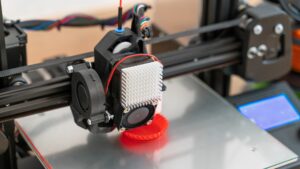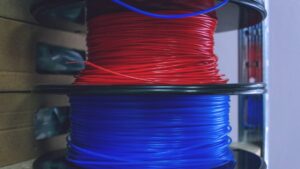
A Look at the Different Densities of 3D Printing Materials
There’s so much to learn about 3D printing materials. Come and find out what to look for when examining the different densities of 3D printing filaments.
844-810-1385
Nylon carbon fiber is one of the most technically useful filaments in the 3D printing world, especially in the manufacturing sector. But it is also one of the most challenging with which to work. It is possible, however, to improve the process of 3D printing with the material. After learning our tips for printing with nylon carbon fiber filament, you’ll want to keep this blog bookmarked for later.
Unless you keep your printer in a dry room at 100°C, your project needs an enclosed environment. Why, you ask? Cooling, padawan, cooling. If nylon prints cool too quickly, they warp. So be kind to your print and give it a warm home. A very warm home—100°C is great if your setup permits it.
3D printing isn’t a race. OK, I guess you could have 3D print racing, but that’s for another blog post. Remember that nylon carbon fiber (nylon CF) is nylon with little, tiny carbon fiber strands embedded in it. Those strands are not aligned, and if you print too fast, they can jam in your print nozzle, resulting in…a clog. So take it slow and easy, perhaps 30 to 50 mm/s.
Nylon is hygroscopic. OK, a side note here. People frequently confuse hyGROscopic with hyDROscopic. It’s easy to do and, in fact, they are one and the same, with hydroscopic being a mispronunciation of hygroscopic. You can go down that rabbit hole here. So, impress your friends; say hyGROscopic.
Now back to our regularly scheduled blog. Nylon is hygroscopic, meaning it likes water like a fish, and it will absorb it in humid environments. This is bad for your printing, because the nozzle is about 250°C, and water boils at 100°C. Thus, all of that water in the nylon turns to steam. You will know this as your nozzle pops and spits filament, and your print looks like, well, crap.
What does this mean in practice? Dry your filament and keep your filament dry when printing. If your printer is in a humid environment and you have a long print time, you may even need to use an in-line filament drier.
Remember back about three paragraphs when I said nylon CF is full of itty-bitty carbon fiber particles? Those things are abrasive! They will wear out a brass nozzle in no time, and this leads to ragged-looking prints. Get a steel or ruby-lined nozzle for nylon CF. Such nozzles are also good for nylon glass and even filled-PLA (like glow-in-the-dark) filaments.
Unless you just don’t care about the cost of nylon CF filament, you might want to optimize your print with something decidedly less expensive, like PLA. If you are doing a new design (not a download), then you may make five, 10, 20, or even more iterations getting everything tuned just so. Why use slow-printing, expensive nylon CF for this process?
I’m going to discuss this very thing in an upcoming blog post. It seems a rogue 4×4 post fell on my auger power head and split the intake manifold. A replacement manifold was not available, so it was 3D design and print time. And I needed the auger in seven days. I’ll lay out the process and show the final part, which was printed in Filamatrix nylon CF for strength and heat resistance.
There is much more to learn about 3D printing with nylon carbon fiber filament. Look around our blog for more tips, tricks, and ideas on tackling common questions and concerns with common filament types.
Filamatrix is here for you—the maker/engineer/designer/builder/machinist/person who does additive manufacturing. We offer outstanding US-made (yes, MADE—in Bristol, Virginia) material selections, including 3D printer carbon fiber filament. Explore our online shop for more choices of materials to use in your next 3D printing project.

There’s so much to learn about 3D printing materials. Come and find out what to look for when examining the different densities of 3D printing filaments.

Those interested in 3D printing have a lot to learn on how to use the system properly. Find out what you need to know about 3D printing and humidity levels.

3D printing has many variables that both beginners and experts need to know. Find out what effects temperature has on 3D printer filament.
Get professional insights, industry news, and our latest deals